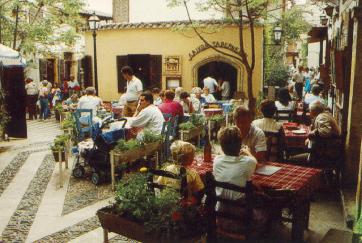

The town planning was a result of a way of living: narrow streets with houses built next to each other.
The buildings we see today basically date from the end of the 18th and 19th centuries, and they have all the characteristics of houses built within fortifications. Their design is also proof that architecture has managed to combine both worlds, the East and the West. Greek, French, Venetian and Turkish details, all mix in a typical Cypriot expression. The basic materials used for the buildings were wood, sandstone, and mudbrick. The combination of all these different materials gives us today an example of fine architecture.
Until 1960, old Nicosia still retained all these characteristics, which gave the city its architectural character. In the next 20 years, Nicosia experienced a series of transformations both in the natural environment, as well as in the social environment, due to the demanding pressure for the development of the city.
The sudden change, found the city unprepared and unable to cope with the new needs. As a result of this change, the sudden development caused serious destruction to the historical character of the city.
The "green line" divided the walled city, and aggravated the situation, by litteraly cutting in two the historical center, thus creating a problem to the city itself, and to all those who had to abandon their homes, because of the proximity of the green line. Gradually, the old town, - that once was full of life and commercial activity, is abandonned, and people look for solutions outside the fortifications. The old part of our city, our historical center, was withering away, and problems within the walls just increased every day - traffic, lack of green areas, difficult living conditions and other problems. The Government of Cyprus, being aware of the problem the old city faced every day, decided in 1977 to expropriate the area of Laiki Yitonia, a small area not bigger than 1000 square meters. The main aim was to breathe new life to the city within the walls, by creating a nucleus with a very strong folkloric character, that would combine, commercial and cultural activities.
The basic scope of our government was to give a real example for the revival of the old city that would guide the way to a development of Nicosia, that would also safeguard in this way, its architectural character and its tradition.
Return to main.